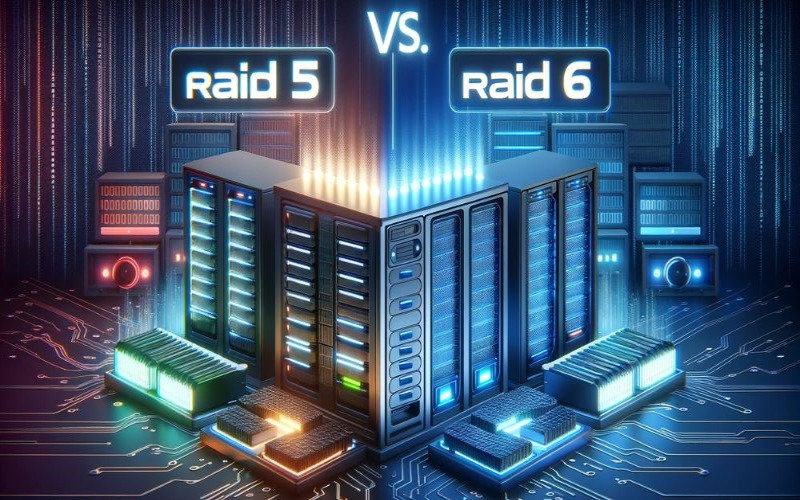RAID, or Redundant Array of Independent Disks, is a data storage technology that combines multiple disk drives into a logical unit to provide enhanced performance, data redundancy, and fault tolerance. RAID systems distribute data across multiple disks, which can improve read and write speeds while also protecting against data loss in the event of a disk failure.
In today’s data-driven world, organizations rely heavily on their digital assets, making data protection and availability critical. Disk failures are a common occurrence, and the loss of valuable data can have severe consequences, including financial losses, operational disruptions, and reputational damage. RAID systems offer redundancy by storing redundant data or parity information, allowing for data recovery if one or more disks fail.
RAID 5 and RAID 6 are two popular RAID levels that provide data redundancy and fault tolerance. RAID 5, also known as striped parity, distributes data across multiple disks along with parity information, allowing for the reconstruction of data if a single disk fails. RAID 6, or double parity, offers an additional level of redundancy by using two sets of parity data, enabling data recovery in the event of two simultaneous disk failures.
Understanding RAID 5
RAID 5 is a data storage configuration that stripes data and parity information across multiple disks. It requires a minimum of three disks, with one disk dedicated to storing parity data. The parity data is calculated from the data on the other disks, allowing for the reconstruction of data if one disk fails.
In a RAID 5 array, data is divided into blocks and distributed across the available disks, along with parity information. The parity data is calculated using an exclusive OR (XOR) operation on the corresponding data blocks from the other disks. This parity information is rotated across all disks, ensuring that no single disk carries a disproportionate load.
RAID 5 provides fault tolerance against a single disk failure. If one disk fails, the data from the remaining disks and the parity information can be used to reconstruct the missing data. This process is known as a RAID rebuild, and it allows the array to continue operating without data loss until the failed disk is replaced.
While RAID 5 offers data protection, it can introduce a performance penalty, particularly for write operations. Every write operation requires the calculation and updating of parity data, which can result in additional overhead and potentially slower write performance compared to non-redundant configurations.
Advantages of RAID 5 include:
- Data redundancy and fault tolerance against a single disk failure.
- Efficient use of disk space compared to mirroring (RAID 1).
- Improved read performance due to data striping.
Disadvantages of RAID 5 include:
- Reduced write performance due to parity calculations.
- Vulnerability to data loss in the event of multiple disk failures or unrecoverable read errors (UREs).
- Potential for performance degradation as the array size increases.
Delving into RAID 6
RAID 6, also known as double parity RAID, is an extension of RAID 5 that provides additional fault tolerance by using two sets of parity data. Like RAID 5, data and parity information are striped across multiple disks, but RAID 6 calculates and stores two independent parity datasets, enabling data recovery in the event of two simultaneous disk failures.
The key advantage of RAID 6 over RAID 5 is its ability to withstand two concurrent disk failures without data loss. This is achieved by calculating two sets of parity data using different algorithms, typically Reed-Solomon or P+Q coding. If two disks fail simultaneously, the remaining disks and the two parity datasets can be used to reconstruct the missing data.
Like RAID 5, RAID 6 introduces additional overhead for write operations due to the calculation and updating of dual parity data. This overhead can result in lower write performance compared to non-redundant configurations or even RAID 5. However, the read performance of RAID 6 is generally similar to that of RAID 5.
Advantages of RAID 6 include:
- Enhanced fault tolerance against up to two concurrent disk failures.
- Increased data protection compared to RAID 5.
- Improved reliability for larger arrays or arrays with higher disk failure rates.
Disadvantages of RAID 6 include:
- Reduced write performance due to dual parity calculations.
- Higher storage overhead compared to RAID 5 (two disks dedicated to parity data).
- Increased complexity and potential compatibility issues with some hardware or software configurations.
Factors Influencing the Choice
The primary consideration when choosing between RAID 5 and RAID 6 is the level of data protection required. RAID 5 provides adequate protection against a single disk failure, while RAID 6 offers enhanced fault tolerance against two concurrent disk failures. Organizations with mission-critical data or stringent uptime requirements may opt for RAID 6 to minimize the risk of data loss.
Both RAID levels introduce performance trade-offs, particularly for write operations. RAID 5 generally offers better write performance than RAID 6 due to the lower parity overhead. However, RAID 6 may be preferred for read-intensive workloads or applications where write performance is less critical.
RAID 6 arrays require more disks than RAID 5 due to the additional parity disk, which increases the overall cost of the storage solution. Organizations with limited budgets or less demanding data protection requirements may opt for RAID 5 to strike a balance between cost and redundancy.
As storage arrays grow larger, the risk of multiple disk failures increases. RAID 6 provides better protection for larger arrays or scenarios where disk failure rates are expected to be higher, such as in environments with older or less reliable disks.
Different applications and workloads may have varying requirements for performance, data protection, and reliability. Organizations should carefully evaluate their specific workload characteristics and application needs when deciding between RAID 5 and RAID 6.
Performance Comparison

In general, RAID 5 arrays tend to offer better write performance compared to RAID 6 due to the lower parity overhead. However, read performance is typically similar between the two RAID levels, as both leverage data striping for improved read throughput.
During a disk failure and subsequent rebuild process, both RAID 5 and RAID 6 arrays may experience performance degradation. However, RAID 6 arrays are better equipped to handle multiple disk failures without compromising data integrity, while RAID 5 arrays risk data loss in the event of a second disk failure during the rebuild process.
Numerous benchmarking studies and real-world deployments have compared the performance of raid 5 vs raid 6 arrays under various workloads and conditions. These studies can provide valuable insights into the actual performance differences and help organizations make informed decisions based on their specific requirements.
Data Protection and Fault Tolerance
RAID 6 offers superior data protection and fault tolerance compared to RAID 5. While RAID 5 can tolerate a single disk failure, RAID 6 can withstand up to two concurrent disk failures without data loss. This enhanced resilience becomes increasingly important as the number of disks in the array grows, as the likelihood of multiple disk failures increases.
Statistical analyses and modeling can help quantify the probability of data loss in RAID 5 and RAID 6 arrays under different scenarios. These analyses consider factors such as disk failure rates, array sizes, rebuild times, and the occurrence of unrecoverable read errors (UREs).
During the disk rebuild process, both RAID 5 and RAID 6 arrays are vulnerable to data loss if additional disk failures or UREs occur. However, RAID 6 arrays are generally more resilient to UREs and provide a higher likelihood of successful data recovery due to the additional parity data.
Scalability and Flexibility
Both RAID 5 and RAID 6 arrays can be expanded by adding additional disks, allowing organizations to scale their storage capacity as needed. However, the expansion process may differ between the two RAID levels, and organizations should consider the potential impact on performance and rebuild times as the array size increases.
As the number of disks in a RAID array increases, the performance and rebuild times can be affected. Larger RAID 5 arrays may experience more significant performance degradation during rebuild processes, while RAID 6 arrays can better maintain performance and data protection due to the additional parity data.
Organizations should consider the compatibility of RAID 5 and RAID 6 with their existing hardware and software environments. Some storage solutions or operating systems may have limitations or specific recommendations regarding RAID levels, which could influence the choice between RAID 5 and RAID 6.
Cost Analysis
RAID 6 arrays generally have higher initial setup costs compared to RAID 5 due to the additional disk required for the second parity set. This cost difference can be significant, especially for large arrays or installations with numerous RAID groups.
While RAID 6 arrays may have higher upfront costs, organizations should consider the total cost of ownership (TCO) over the entire lifespan of the storage solution. Factors such as potential data loss, downtime, and recovery efforts can significantly impact the overall costs and should be factored into the analysis.
To make an informed decision, organizations should conduct a comprehensive cost-benefit analysis that considers the trade-offs between performance, reliability, and cost. This analysis should take into account the specific requirements, workloads, and business priorities of the organization.
Real-World Use Cases
Different industries and applications may have varying requirements for data protection, performance, and reliability. For example, financial institutions or healthcare organizations may prioritize data integrity and fault tolerance, making RAID 6 a more suitable choice. On the other hand, media and entertainment companies with large datasets and high-performance demands may find RAID 5 more appropriate for their workloads.
Real-world case studies of organizations that have implemented RAID 5 or RAID 6 can provide valuable insights into the decision-making process, deployment challenges, and operational experiences. These case studies can help organizations better understand the practical implications of each RAID level in different scenarios.
By analyzing the experiences of organizations that have deployed RAID 5 or RAID 6, valuable lessons can be learned and best practices can be derived. These lessons may include considerations for monitoring and maintenance, disaster recovery planning, and strategies for balancing performance, reliability, and cost.
Conclusion
In this comprehensive analysis, we have explored the fundamental differences between RAID 5 and RAID 6, their respective advantages and disadvantages, performance considerations, data protection capabilities, and cost implications. While RAID 5 offers a balance between redundancy and cost, RAID 6 provides enhanced fault tolerance at the expense of increased complexity and potentially lower write performance.
The choice between RAID 5 and RAID 6 ultimately depends on the specific requirements and priorities of the organization. RAID 5 may be suitable for environments with moderate data protection needs, limited budgets, or workloads that prioritize write performance. RAID 6, on the other hand, is recommended for mission-critical applications, larger arrays, or scenarios where data integrity and fault tolerance are paramount.
As storage technologies continue to evolve, new RAID levels and innovations may emerge to address emerging challenges and requirements. Organizations should stay informed about the latest developments in RAID technology, such as erasure coding, distributed RAID, and software-defined storage solutions, to ensure they remain at the forefront of data protection and performance.

